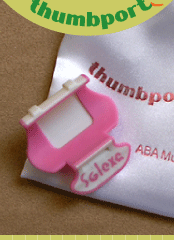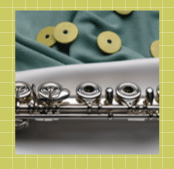

1. How and why did you come up with this product?
2. When I try the Thumbport my right wrist wants to be very high....is that right?
4. Is it only a teaching/learning aid?
5. My thumb seems too long to put at the place where you recommend.
6. Why did you not make it to fit the case?
7. Any possible modifications?
9. Why do you have different colors? How do they differ?
10. How about Thumbports for other flute family instruments?
11. Do you have a solution for the left hand?
12. What is the difference between the Thumbport and Thumbport II?
1. How and why did you come up with this product?
It all started when Ho-Fan Lee picked up the flute in the 5th grade. The pressure of studying for exams in the junior high school made him look for refuge (this was in Taiwan). Flute playing was the perfect answer. He injured his right pinky by over-practicing the flute before 15 years of age. He had always thought that it might have been an inherent problem of playing the flute or caused by his incorrect holding of the flute. Whatever it was, this injury contributed negatively to the development of his flute skills and this damage was irreversible.
Learning the three-point support system was a new direction for better flute playing when he went to study with William Bennett at the Royal Academy of Music, London. The idea was that if one could balance the flute with only the chin, the first knuckle of the left index finger, and the right thumb, all the key playing fingers would be free from excessive stress and strain, thus it would spare those fingers for more effective operation. This method would require the right thumb to be supporting the flute not directly under the F key but moving back toward the palm (on the side of the flute). The right thumb would push the flute diagonally—approximately 30° to 45° from the vertical line. This position is referred to by many as the “modified Rockstro” position. It helped Ho-Fan a great deal, but, because of his early injuries, he was still having considerable pains after practicing for merely 15 to 20 minutes.
After moving to Cleveland, Ohio, USA in year 2000, he had the fortune to meet professors Michel Debost and Kathleen Chastain at the Oberlin Conservatory. He audited some of their lessons and classes at various occasions. One of Prof. Debost's main ideas was about the stability. Prof. Debost demonstrated many a time how a steady flute could produce better and more consistent sound. Then, Ho-Fan saw the Thumbalina (a product manufactured and marketed by Roger Holman) in 2004. It gave him additional stimulation. If configured properly, the Thumbalina could balance the flute quite well, but he wanted to make something more configurable and easier to handle. Thumbport was born out of all the above inspirations. To Top.
2. When I try the Thumbport my right wrist wants to be very high....is that right?
You might be doing one of two things: 1. the right thumb pushes directly against the extension arm, or 2. you have the extension arm configured too high. In the first scenario, simply put the thumb against the flute and have the extension arm rest lightly on the side of the thumb. In the latter, please re-configure the Thumbport so the extension arm will reach the side of the thumb naturally. One can achieve this just by scooting the Thumbport down so the extension arm sits lower on the flute tube.
To raise a flutist's wrist is not a goal of the Thumbport.
If you support the flute from underneath the flute with your right thumb, there is a tendency to raise the wrist to touch the extension arm. To Top.
3. I'm not used to playing with my thumb at the back of the flute, but rather underneath the flute. How can I get used to this change?
First, do not change your position but configure the Thumbport so it reaches the thumb naturally (sometimes it's necessary to cut a notch at the front of the Thumbport in order to fit around the tone hole). Although this way it lacks a counter force to the horizontal rotation mentioned in the Analysis & Discussion, it still helps to get rid of the rolling. However, one will still need much help from the right little finger to stabilize the flute in this configuration.
If one is courageous enough to learn the three-point balance support system, the benefit will be self-evident. Here it goes: try to hold the flute with only the chin, the first knuckle of the left index finger, and the right thumb (without the Thumbport initially). It may take a while to find the best spot for the right thumb, but be persistent. The thumb will eventually be supporting the flute from the back with an approximate 30° to 45° angle. Some people refer this as "supporting the flute diagonally". You would be ready for the Thumbport now. Just following the instruction earlier, you should find it assuring. The flute will stay in its place firmly.
There are three fundamental forces to counter with in a flute supporting system. And there are two contact points when using the Thumbport (one pushing against the flute tube, which contains two vectors; the second passively counters the rolling by the extension arm sitting on the side of the thumb). Because, without the Thumbport, those three forces (or vectors) are dealt with only by one point from the thumb balancing the instrument, it is a very delicate situation. Many people have differing problems because of this.
Please contact me if you have any questions. To Top.
4. Is the Thumbport only a teaching/learning aid?
Not exactly. From the inception the Thumbport had in mind all professionals, beginners, and everybody else. Because the flute has inherent balance issues, the Thumbport will help flutists of all levels. A circular object does want to roll with even a tiny force. It needs something to stabilize it--people still use wheel wedges to secure a parked airplane. To Top.
5. My thumb seems too long to anchor at your recommended place.
It is difficult for people with long thumbs to hold the flute anyway; it is not a proprietary phenomenon to using the Thumbport. It requires some clever planning to solve this problem. In very few cases, the current Thumbport model may not be helpful to people with extra long thumbs. To Top.
6. Why did you not make it fit into the case?
The functionality precedes the form here. If the current Thumbport model is configured all the way against the rib of the flute, it has difficulty in getting into slim cases. Most people find the Thumbport comfortable when the extension arm points downward a little more (away from the rib). It then gets into the case with the flute without a problem. The main concern when designing the Thumbport was to work well for the player, not the case. To Top.
7. Any possible modifications?
Certainly. Please see the MODs page. Also, please keep in mind that the Thumbport is made of two materials. The soft part is in contact with the flute. This material will not scratch the metal and does not slide easily. One can scoot it along the tube to find the best position. For many flutists, the extension needs to point closer to the floor. To Top.
8. I do not experience pain and feel comfortable with my holding of the flute. Does it benefit me to use the Thumbport?
Yes, it does. There are several ways to cancel out the rolling tendency of the flute. They all require varying degrees of effort. The Thumbport will relieve these efforts so the player can focus on other music making aspects of flute playing. To Top.
9. Why do you have different colors? How do they differ?
Many people have been asking for colors that would conceal the Thumbport better on stage. The black-grey works well with silver flutes and the copper-white with gold flutes. The ivory-emerald green one is for people who simply like different visual experience (same goes for the pink and purple ones). We now have seven different combinations. As of 2008, the black-grey has the grey color on the outside hard shell so it blends in with the silver flute better from the audience side. To Top.
10. How about Thumbports for other flute family instruments?
Thumbports for the alto and piccolo have been released. Please find your preferred vendors and ask for them.
As for the bass, the sheer weight of that instrument calls for something more substantial. We are investigating possible solutions. To Top.
11. Do you have a solution for the left hand?
The flute has a circular tube. It is the source of instability. Try to lay a pipe on the floor and see how easily it rolls with any external force... My idea is very simple--to provide a large flat surface at where the left index finger supports the flute. This device also acts as a rest for the pinkie, which is a realization of Michel Debost's idea. Please go to the Product page for information. To Top.
12. What is the difference between the Thumbport and Thumbport II?
The Thumbport II has a lower default angle for the thumb. It's a little thicker and more rigid. It has less contact with the flute. And, its extension arm is a little shorter (when attached to the flute, it may go into the case easier for most). Also the end of the extension has a more rounded edge.
If the default angle on the Thumbport II (when the back top end pushes against the flute rib) is too low, one can use a blade to cut off the end a little. The angle can be modified in this manner. Adding isn't as easy as removing; that is the reason why the new shell is longer.
Some players still prefer the older design. The Thumbport and Thumbport II are available concurrently. To Top.
